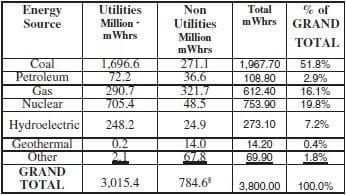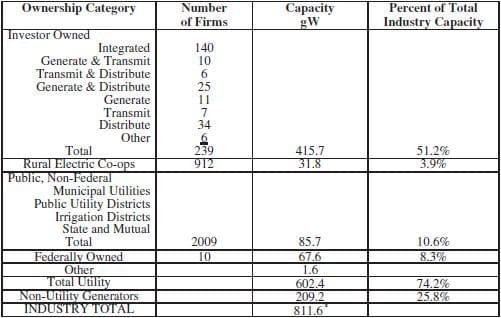Producing electricity
There are a number of ways to produce electricity, the most common commercial way being the use of a synchronous generator driven by a rotating turbine. The combination is called a turbine-generator.
The most common types of turbine generators are those where a fossil fuel is burned in a boiler to produce heat to convert water to steam which drives a turbine.The turbine is attached (coupled) to the rotating shaft (armature or rotor) of a synchronous generator where the rotational energy is transformed to electrical energy. In addition to the use of fossil fuels to produce the heat required to change the water to steam, there are turbine generators which rely on the fission of nuclear fuel to produce the heat.
Other types of synchronous generators are those where the turbines are driven by moving water (hydro turbines) and gas turbines which are turned by the exhaust of a fuel burned in a chamber containing compressed air. For each type system, there are many variations incorporated in the power plant in order to improve the efficiency of the process.Hybrid systems are also in use; an example is a combined cycle system where the exhaust heat from a gas turbine is used to help provide heat for a steam driven turbine. Typically, more than one these generating facilities were built at the same site to take advantage of common infrastructure facilities, that is, fuel-delivery systems, water sources and convenient points to connect to the delivery system.

* Non Utility Value is preliminary.
A small, but not insignificant, segment of the electric generation in the country includes technologies that are considered more environmentally benign than traditional sources; that is, geothermal, wind, solar, biomass. In many of these technologies dc power is produced and use is made of inverters to change the dc to the alternating current (ac) needed for transmission and use.

* EIA data for utility generation in 2000 indicates two values; 604,513 mW used in Figure 1 and 602,377mW.
Figure 1 shows a total of 811,625 megawatts of utility and non-utility electric generating capacity in the United States in 2000. Figure 2.1 shows the various energy sources used. Generators are selected, sized and built to supply different parts of the daily customer load cycle. One type generator might be designed to operate continuously at a fixed level for the entire day. This is a base loaded generator. Another generator might be designed to run for a short period at times of peak customer demand.This is a peaking generator.Others might be designed for intermittent type service.
One important aspect of the selection of a particular generator is the trade off between its installed cost and its operating costs. Base loaded generators have much higher installed costs per unit of capacity than peaking generators but much better efficiency and lower operating costs. Included in this decisionis the availability and projected cost of fuel.
Prior utility practice has been to have enough generation available to meet the forecast customer seasonal peak demand plus an adequate reserve margin. Reserve margins were determined by conducting probability studies considering, among other things, the reliability of the existing generation and potential future loads. Systems that were mainly hydro generation based had lower reserve margins (~12%) than systems that had nuclear, coal, or oil fired generation (~16–24%).
The availability of aid from neighboring systems during shortages also had a large impact on the required reserve.










